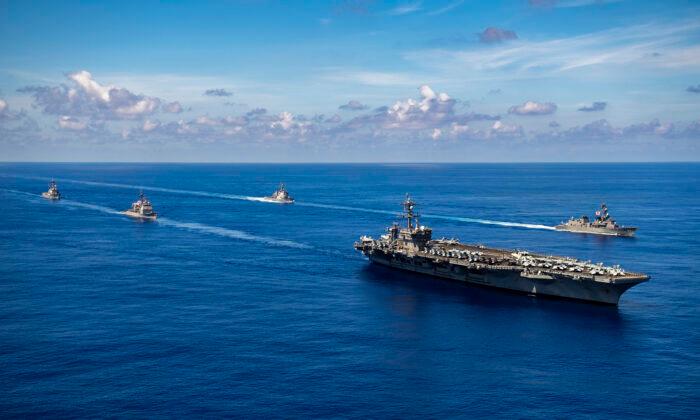The Quadrilateral Security Dialogue, colloquially called the “
Quad,” commenced the second phase of its joint military exercise Malabar on Oct. 12, bringing together elements of the Australian, Indian, Japanese, and American militaries in the Bay of Bengal. The exercise is the 25
th of its kind, and will continue through Oct. 15.
The drills come amid rising concern among Western and Asian states over the Chinese regime’s growing military assertiveness in the Indo-Pacific, and as the United States seeks to shore up partnerships, including the
Quad, to counter threats posed by Beijing.
This year’s Malabar exercise was
designed to enhance synergy, coordination, and interoperability between the four nations’ forces, with a particular focus on developing advanced surface and anti-submarine capabilities.
Several sizeable seacraft including the USS Carl Vinson aircraft carrier, which has seen deployments in almost every major conflict since 1980, are participating in the drills, which will build upon experience gleaned from the
first phase of the exercise, which took place near Guam in August.
Sam Kessler, a geopolitical adviser at the multinational risk management company North Star Support Group, said that the strong focus on building interoperable forces that can work cohesively as one unit was central to developing a more capable international presence.
“Interoperability helps the participating nations to learn how to operate together in both peace and security scenarios,” Kessler said. “Whether it’s to refuel, re-equip, or to work together on missions of war and peace, the exercise helps figure out how best to do that.”
“The Quad and the exercises offer an opportunity to explore new ideas and possibilities while working on relevant engagements that promote security and a free and open Indo-Pacific at the same time.”
Malabar began as a joint initiative between the United States and India in 1992. It has evolved considerably since then, drawing in both Australia and Japan, largely in response to concerns about increasing adventurism by the
Chinese Communist Party.
The October phase of the Malabar exercise marks the first Quad exercises held since Australia, the UK, and the United States announced their military partnership,
AUKUS, on Sept. 15, which will furnish the Australian military with a fleet of nuclear submarines. That deal is likely one reason that Malabar is now focusing so heavily on interoperability, as Australia, the UK, and the United States will effectively be using different models of the same torpedo and submarine technology, according to Kessler.
“Since Australia recently joined the Malabar exercises in 2020, this gives them an opportunity to start utilizing elements from the recent AUKUS agreement that deals with submarine warfare, technology, and other defense and security capabilities,” he said.
Kessler also noted that the exercises could serve as a means of ensuring that India is kept in the loop strategically, despite not being party to the AUKUS agreement.
“It’s an opportunity to not only streamline the agreement’s purpose but to also get other Quad members more in sync with their goals and objectives as well as potential for any future upgrades and additions to AUKUS.”
Coinciding with this second phase of Malabar, Admiral Mike Gilday, U.S. chief of naval operations, is conducting a tour of India, where he is expected to meet with his counterpart and other senior leadership from the Indian Navy.
A
statement by the U.S. Navy said that the trip was designed to reaffirm American commitments to the expanding naval cooperation between the two nations and to champion their shared desire for a free and open Indo-Pacific.
The move also follows a
statement released by the Pentagon earlier in October, reaffirming the United States and India’s bilateral commitment to information-sharing, high-end maritime cooperation, logistics, and defense trade.
Tying these various strategic threads together is the fact that the United States is currently
expanding its military footprint in the Indo-Pacific, beginning with a new military base in Micronesia and increased aircraft rotations in Australia’s Northern Territory. From there, it is likely that AUKUS, the Quad, and any similar future offshoots will provide the framework for increased allied naval operations throughout the region, the analyst noted.
“The Quad is like a testing ground for developing potential defense treaties in the future,” Kessler said. “Countries like India, Japan, South Korea, and Vietnam have similar concerns about China’s growing expansionism but have different priorities, goals, and objectives on how to go about it.”





